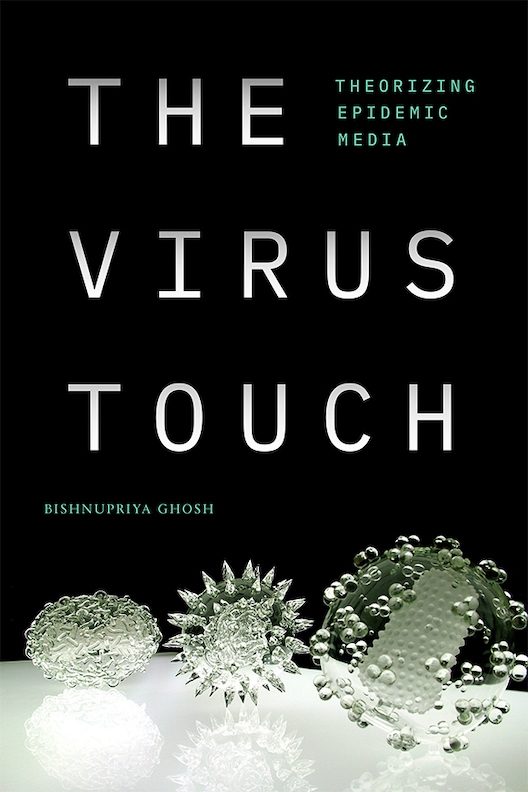
From HIV-AIDS to COVID-19, scholar Bishnupriya Ghosh unpacks decades of research to better understand the complexities of living with viruses
As much of the world has come to know over the past three years, a viral pandemic can be as mysterious as it is detrimental. Its potential impact is a variable gestalt of dispassionate science, election-year politics and social and traditional media.
These interwoven complexities and many others fall under the scholarly command of Bishnupriya Ghosh, a professor of English and of global studies at UC Santa Barbara. Her latest book, “The Virus Touch: Theorizing Epidemic Media” (Duke University Press, 2023), explores relationships between viruses, humans, animals and the environment to show how various forms of media — from news content to lab test results — create our understanding of epidemics.
As health officials report that COVID-19 cases are starting to climb, The Current caught up with Ghosh to discuss the book’s origins and topics.
The Current: Tell us a bit about your background and how you first became interested in theorizing epidemic media.
Ghosh: I am a media studies scholar whose prior research was on literary and audiovisual media. My emphasis was on knowledge production from the Global South and what that means for the distribution of social inequities across the world.
In the early 2000s, right after the state surveillance of Muslim citizens post-9/11, I became interested in how media, from audiovisual testimonies to biometric imprints, “produced” risk, thereby segregating potentially dangerous people from a general citizenry. At the same time, as many in my generation, I was still grieving those lost — 38 million deaths worldwide — to the HIV/AIDS pandemic of the late 20th century.
Starting around 2007, the book’s concept was born in this nexus of media and risk, initially planned as two essays on risk-bearing HIV-infected subjects from India and South Africa, two nations with high death tolls in the HIV/AIDS era.
From an academic perspective, is it accurate to say the book emerged from the fields of media studies and health humanities?
Yes. The book arose mainly from new directions in media studies that plot the relations between media and the environment. Expanding on that concept, media are the natural elements that sustain life, such as air, soil and water, as well as technologies, such as film, television and internet. This got me thinking about not only the relations between life and nonlife at planetary scales but also how we perceive these relations.
The virus is an especially significant form of microbial existence because it is nonlife that takes on lifelike characteristics of irritability and reproduction (but not metabolism). One might say a virus hovers between life and nonlife. It can enter new hosts when interfaces arise from anthropogenic activities, such as deforestation, wildlife trading and industrial agriculture. One of the most common modes of infection is cross-species transmission, called zoonotic spillover, accounting for 60% of viral emergences in the last five decades.
So, acute infectious diseases might be medical crises but the root drivers are ecological upheavals that fragment and destroy animal habitats, creating new wild animal-human interfaces. This is true of HIV, Ebola, Marburg, Hanta and the explosion of new pathogens in the early ‘80s.
Yet during epidemics we tend to think of viral emergences as primarily medical problems with technical solutions, like vaccines and drugs, and we often lose the long view of prevention. One of the key arguments of the book is to think about human health, animal health and biodiversity together, what the World Health Organization characterizes as structural “One Health." If we don’t, we’ll be in the midst of zoonotic spillovers every so often.
Mentioned earlier, your coverage was originally planned as two papers. At what point were you convinced that the topic needed book-length coverage?
The book was partly driven by my own experience of the HIV/AIDS pandemic and the global activism it compelled around health as a distributed good. I had been working on popular movements in South Asia in the late 1990s when the Treatment Action Campaign in South Africa unfolded as an alliance against pharmaceutical empires. That activism and the loss of many in my generation before the arrival of the antiretroviral therapies became motors for knowledge production.
More troubling was the narrative after the antiretroviral hit the market. There was this projection of “The End of AIDS.” But so many pockets in the Global South struggled with healthcare access, food security, housing and so on. Even after four decades, 67% of the HIV-infected are on antiviral therapy. This sense of health injustice and its distributions across the globe seeded the book.
As I looked closer, the sciences of the virus — virology, immunology and epidemiology — commanded a more complex understanding. On the one hand, the HIV/AIDS era shored up the collective distributed experiment in global public health that is now considered “managed HIV.” Yet, the triumphalist narrative was always the scientific discovery that won the day. This undervaluing of all that it takes to implement and sustain managed HIV on the ground was one of the motivations of the book.
On the other hand, as other pandemics broke — such as SARS — acute infectious disease emergence had to be rethought as a planetary concern. At that point, I realized I needed a whole book attuned as much to the world of human affairs as it is to the planet as the entanglement of human and nonhuman forces. How we perceive the tension between the two is crucial.
Your work on this book started long before COVID-19 upended everything in early 2020. How did the pandemic impact your work?
“The Virus Touch” began circa 2007, after SARS and the first three decades of the HIV/AIDS epidemic. COVID-19 broke just as I was finishing up on the animal-host tracking chapter, which is the last chapter in the book. I was very dismayed because I could not see how I could finish a book on viral emergences in the midst of such a globally synchronous event. My dismay grew as I noticed that the lessons learned from the HIV/AIDS era were forgotten — the same mistakes were being made during COVID-19.

What mistakes?
The replay of pharma imperialism in vaccine capitalism, for example. Many of us remember the historic wars between big pharma and global HIV/AIDS activists over the cost of life-saving drugs. Most notable among these were the fights in South Africa over intellectual property rights for antiretroviral therapies after companies in India, Brazil and Thailand had produced cheap life-saving generics. This struggle was repeated in the COVID era, when South Africa and India failed to get the World Trade Organization to suspend intellectual property rights for COVID vaccines, medicines and other new technologies. Putting profit over lives once again — it played like a bad movie.
What else came to mind?
I began to think of what I understood about HIV/AIDS as a necessary historical grounding for pandemics from that point on. After all, we had four decades of HIV biomedical research and HIV/AIDS grassroots activism to draw on for the new pandemic.
As the pandemic wore on, I realized my wager about multispecies relations had relevance for the present. Would COVID infection be intermittent like Ebola outbreaks or would it come to “live with us” like some influenza viruses have?
My curiosity led me to try to situate SARS-Cov2 among all the global viruses I had read about — but most notably smallpox and HIV — and that gave me the push to rethink the book.
For those familiar with your work, what do you hope this book brings to the discussion?
The contribution is twofold. First, to think of epidemics as nonlinear emergences, as biological, social and ecological events. This is a challenge to disciplinary formations such as global or postcolonial studies where public health is exclusively an anthropocentric matter, and the environmental production of the human as a unitary subject is regarded with some suspicion.
Second, for media studies, the effort orients the study of media toward mediation: to inquire into the processes, mechanic and physical, from which “objects” like a photograph or a viral ratio emerge. This shift entails an interdisciplinarity that has become endemic to environmental media studies.
For those unacquainted, what’s the appeal?
The book provides a historical perspective on how we came to think of a medical and public health crisis — an epidemic — as arising from ecological disrepair. The shift into the age of viral storms in the 1980s sets the tone in chapter one. What follows are all the ways in which the technological practices shaping our perception of imperceptible forces — a virus replicating in the body — create objects and environments.
To suddenly see the air between us as a risk environment, for example, is an act of everyday mediation. So, I suppose, the point of “The Virus Touch” is to encourage a kind of media literacy in living with epidemics.
Is there anything you’d like to add?
The book was inspired by those who have made managed HIV successful against the odds and with very few resources. The credit always goes to scientific discoveries. I dedicated the book to all those doctors, nurses, health practitioners and activists, alongside friends, lovers, families, caregivers and the HIV-affected who make it possible to live with HIV.
Keith Hamm
Social Sciences, Humanities & Fine Arts Writer
keithhamm@ucsb.edu



